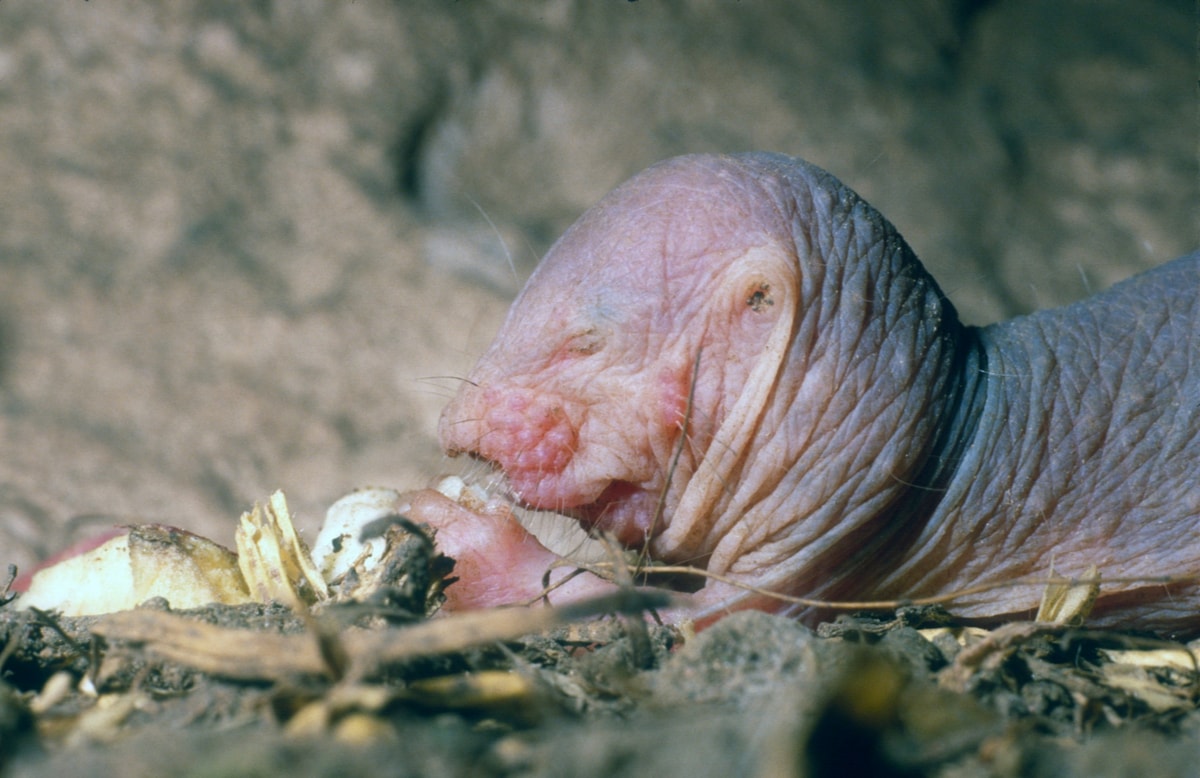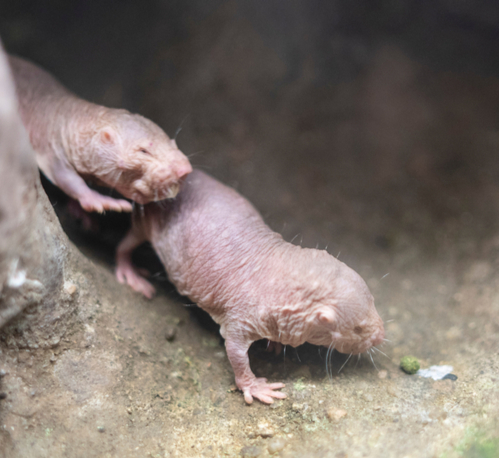Mole-rates: Animals Which Do Not Die From Aging
The savannas and semi-deserts of Eastern Africa are inhabited but a funny-looking animal — a naked mole-rat. It mostly resembles a stale chicken breast, added by beaver’s teeth, tail and four legs, as though added by some creator just for fun. Some may view mole-rats as frightening, while others consider them charming. Meanwhile, scientists have their own opinion: these small ungainly animals can be a key to our immortality!

If the naked mole-rats could rephrase the famous saying, “Live fast, die young,” they would put it like this, “Live long, stay young, and don’t die at all, if possible.” A regular rat’s lifespan is approximately one year and a half, but mole-rats are different — they can easily live as long as 28 or even 31 years if they don’t get killed earlier in a deadly fight with their main enemy — a snake. As a rule, in natural conditions, “old” mole-rats (if they can ever be called “old”) die from heart failure. Naked mole-rats do not suffer from diseases typical of other species in older age, including reduced immunity, diabetes and atherosclerosis. It was long believed that they also don’t get cancer. However, in 2016, a group of scientists had published the research “Initial Case Reports of Cancer in Naked Mole-rats (Heterocephalus glaber)”, which proved the opposite. Two naked mole-rats living in captivity were diagnosed with tumor: one male mole-rat (which was euthanized) was diagnosed with neuroendocrine adenocarcinoma free of metastasis, while the other — undifferentiated adenocarcinoma (after surgery, this mole-rat feels just fine). Nevertheless, the scientists-gerontologists do not lose hope: the frequency of cancer in naked mole-rats is so low that we just have to continue research these species.
How These Amazing Creatures Live
The whole life of the naked mole-rat is spent underground. They feed on roots and almost do not drink water. These babies (8-10 centimeters in length and 30-35 grams in weight) live in colonies headed by a queen, which is a little bigger in size. The colony may consist of 70-80 animals, but there are colonies reaching three hundred model rats. The total length of tunnels, created by naked mole-rats belonging to one colony, can be as long as 3-5 kilometers, with the territory roughly equaling a soccer field. Socially, naked mole-rats resemble ants to a certain degree as the offspring is produced only by the queen and 2-3 fertile males while other mole-rats fulfill various works: taking care of children, gathering food, making tunnels and protecting from natural enemies. The social roles are no fixed: a former “mineworker” can become a “soldier,” while after the queen dies, she is replaced by one of the females that will grow in size. Interestingly, the mole-rats cannot become “babysitters” by chance as was discovered by the Japanese scientists in the year 2018 (“Responses to pup vocalizations in subordinate naked mole-rats are induced by estradiol ingested through coprophagy of queen’s feces”) as they have to eat the queen’s excrements which include estradiol hormone. Considering that the queen will give birth to hundreds of babies during her lifetime, quality care about the younger generation is essential for the colony.
Naked mole-rats do not have very sharp eyes, but they can feel, hear, and smell very well. They even possess a unique vomeronasal organ that helps identify other species of the same kind and determine their status, which is no surprise for such social creatures. Besides, the naked moles can hear sounds for communicating with each other over a much wider range than other rodents.
The model rats resemble a chicken breast not only visually since their bodies are similarly cold with the temperature depending on the environment. As they try to keep warm, the animals gather close together and spend much time in tunnels close to the surface. The naked mole-rats also feel comfortable deep under the earth, where there is a lack of oxygen and lots of carbon dioxide. In a situation when any other animal quickly suffocates and dies, a mole-rat will just feel some discomfort but will soon recover, even after eighteen-minute oxygen deprivation. As was discovered during the research, “Fructose-driven glycolysis supports anoxia resistance in the naked mole-rat”, in the absence of oxygen, the mole-rat switches into the anaerobic metabolism while its brain is supported by accumulated fructose.
Why Scientists Are So Obsessed with Naked Mole-rats

Mole-rats are unique animals as they defy the gompertzian laws (which is the dependency between the increased death rate and age of animals). As was discovered by scientists in the research of the year 2018, “Naked Mole-Rat mortality rates defy gompertzian laws by not increasing with age”, the “aged” mole-rats are energetic and full of fun and don’t lose the reproductive or muscular functions with age. And as though the above is not enough, the mole-rats are practically insensitive to cuts and burns, including acid burns. As it was found by scientists in the research “Hypofunctional TrkA Accounts for the Absence of Pain Sensitization in the African Naked Mole-Rat”, the skin cells of a naked mole-rat are practically devoid of neurotransmitter which is responsible for transmitting the pain signals to the brain. “We assume that the babies were not so happy when they were subjected to acids and capsaicin (which makes the pepper hot), but, in any case, they were not feeling pain, and this is a proven fact,’ scientists say.
The naked mole-rats are interesting for researchers also due to their unique reaction to oxidation. Numerous studies made the last 60 years relate the aging process with the reactive oxygen species (ROS), which negatively affects the cellular mitochondria according to the free radical theory of aging. But in the report of the year 2019, “The Naked Mole-rat: A Unique Example of Positive Oxidative Stress”, scientists have noticed that mole-rats are remarkably resistant to oxidation and actively regenerate damaged cells. In other research, “The anti-tumorigenic activity of A2M—A lesson from the naked mole-rat”, it was reported that the body of a naked mole-rat includes a significant amount of hyaluronan (hyaluronic acid) with very high molecular mass, which actively deduces any inflammation.
Naked mole-rats demonstrate remarkable genome stability, which is essential given inbreeding in the colony. In the research “Genome Stability Maintenance in Naked Mole-Rat”, it was found that functionality of molecular mechanisms prevents damages to the genome, which can be one of the reasons for mole-rats resistance to cancer and their longevity.
The naked mole-rats have another characteristic that can explain their resistance to aging. This is a protracted brain developed which remains “babyish” and, therefore, resistant to degenerative changes (“Protracted brain development in a rodent model of extreme longevity”). The neuroplasticity also allows mole-rats to change their social roles pretty easily.
There are numerous studies devoted to the naked mole-rats since these rather ugly animals can help to find a cure for cancer, increase the lifespan, and discover methods to resist aging. Not bad for such babies! And we would very much like to believe that we are just a step away from immortality.
What to learn more? Read here:





